|
|
 |
|
|
Sturmpanzer IV “Brummbär” Part One
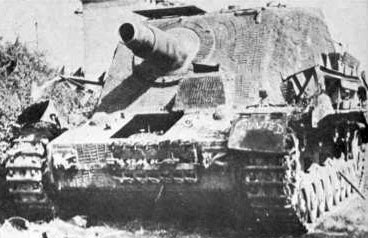 |
Sturmpanzer IV “Brummbär” - Part One
Design and Development
By Wolf Höpper
One of the better-known German special-purpose vehicles is the Sturmpanzer IV “Brummbär” (English: Grizzly Bear). The purpose of these articles is to highlight the different designs, and their employment within the independent Sturmpanzer abteilungs.
Read more about the deployment of the Brummbär here (in Part Two)... |
Check out the Brummbär in the online store...
The problem in researching this subject is that no single comprehensive book (besides the different publications by Markus Jaugitz, some in conjunction with Waldemar Trojca) about the history of the German Sturmpanzer units is available at the moment. The first volume, published by J.J. Feodorowicz Publications is not available to me, so some further information is probably available there. Further information was found in the publications of Karl-Heinz Münch, although only in conjunction with his far more detailed history of the schwere Panzerjäger Abteilungen 653 and 654.
|
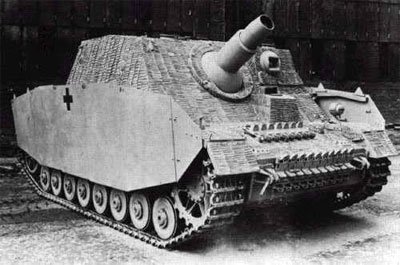
|
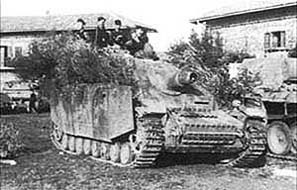
|
The combat histories of the different units have to remain sketchy, since the available information is rather scarce, especially the StuPzAbt 217’s deployment in September 1944 around Aachen, an area that is not documented very precisely. Most combat accounts only refer to state the employment of assault guns in general, so differentiation between the different assault guns and assault panzers cannot be verified.
Unfortunately, the second volume of “Sd Kfz 166 Brummbär” by Waldemar Trojca/Markus Jaugitz, which will cover that unit’s history is not available/published at the time of writing. Most likely this book will provide further information.
|
Acknowledgement and Disclaimer
Acknowledgement
I hereby would like to express my deep thanks to Niklas Zetterling for his permission, to use the information about the combat history of StuPz Abt 217 during Normandy. He compiled it through the use of original documents. He compiled the data and published them in his book "Normandy 1944, German Military Organization, Combat Power and Organizational Effectiveness". ISBN 0-921991-56-8.
|
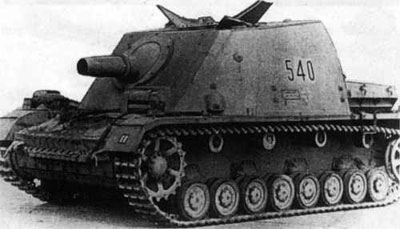
|
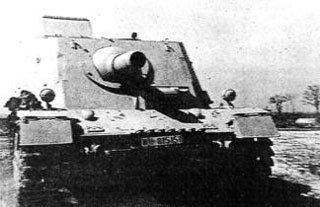 |
Disclaimer
The author is not a trained graduated historian, however important quotations, historical events and the like are marked in the article and can be checked by the reader. This article doesn’t lay claim to be the final examination nor the final historical analysis of the pictured events/subject. The author wrote this article as correctly as possible without bending historical accuracy or changing events, times or other relevant parts. It was intended to provide both the serious military student and the every-day reader alike with a detailed account of the events in the mentioned time frame and analyse it from a mostly militaristic point of view. |
All facts, as far as they can be ascertained by more than one independent source, were taken from books written in German and German/English written web pages. So any mistakes which might occur through misinterpretation, wrong translation, wrong counter-checking the different sources, or other circumstances, are the ones made by the author alone. Any corrections, further information or comments are very welcomed
Wolf Höpper, Neu-Ulm, Germany. |
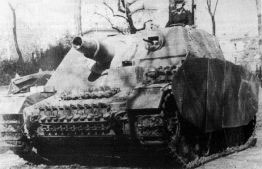
|
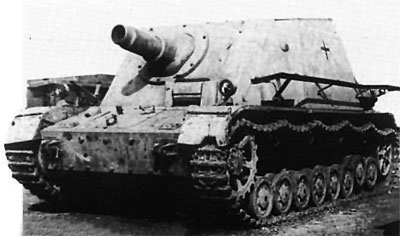 |
Design History
The fighting for Stalingrad made it obvious that the German army was clearly lacking an infantry support vehicle that was capable of providing enough fire support with sufficient destructive capability. Especially a weapon that could level an average city house with no more than two or three shots. The current available vehicles were either stop-gap measures, like the sIG 33 B on a Panzer III, or simply outdated, like the various sIG on Panzer I and II models.
|
The StuG III, initially intended for that employment, lacked the gun for it and they also had to be employed more and more as a stopgap anti-tank measure.
The need for such a vehicle was already recognised in 1941, when on June 9th a demand was made to mount a 15 cm sIG on a heavily armoured hull.1 |
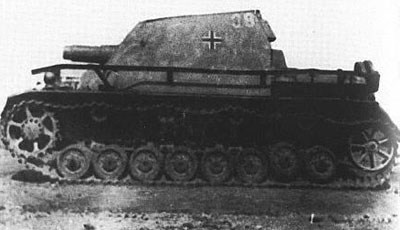 |
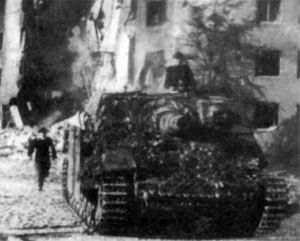 |
The German manufacturer Alkett presented their design drawings to Hitler on 14th October 1942, where they had mounted a modified sIG on a Panzer IV chassis in a StuG like fashion. Hitler approved the design, and demanded, that the new sIG should fire very thinly covered shells, to improve their high-explosive capability.2
The first model photos were shown to Hitler on February 7th 1943, and the need for a first production series of 40 vehicles was specified. On his order dating February 7th 1943, it was demanded, that they be completed by 12th May 1943. Thereafter another 20 vehicles were scheduled for production. The vehicle received the unofficial numbering “Gerät 581 – Sturmpanzerwagen 604/16 (ALKETT) sIG auf PIV mit kardanischem Fahrwerk.” That was changed to Sd.Kfz 166 in April 1943.3
|
Production
Skoda developed the new sIG gun and manufactured 6 in March, 40 in April and 14 in May. In the same month the new gun was designated the 15 cm Sturmhaubitze 43/1 (L/12) (assault howitzer). Hitler ordered that the vehicles should be put under the command of the general inspector of the panzer forces since they were considered part of the panzers forces and not the artillery.4
Hitler ordered, that the new vehicle should be labelled “Sturmpanzer” (assault tank) in May 1943.5
|
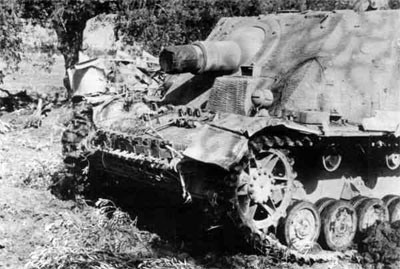 |
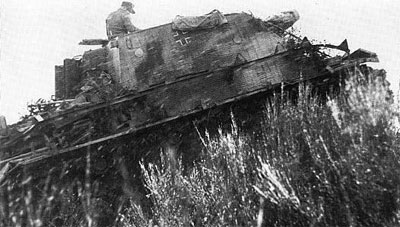 |
Initial production started in April 1943. The Nibelungen plant at St. Valentin converted 20 in that month from reconstructed/repaired vehicles, and in May a further 32. The upper structures were manufactured by Eisenwerke Oberdonau (42) and Böhler at Kapfenberg (10). Responsibility for the overall production program rested with the Austrian Saurer and Simmering-Graz-Pauker companies.6
Another source states that the initial series of 52 vehicles was manufactured from new Panzer IV/Gs and another 8 converted from repaired Panzer IV/Es and Fs.7 |
Hitler inspected the first production model on May 14th 1943. He was convinced that as soon as the new vehicles proved their effectiveness, the front-line troops would demand additional vehicles. He ordered an investigation to see if Panzer IVs sent back from the front for reconstruction/repair could be diverted to the production of the new vehicle.8
After the first trials it was discovered that with a 5 man crew, 38 rounds of ammunition and the large fighting compartment the estimated weight of the new assault tanks 28.2 tons. |
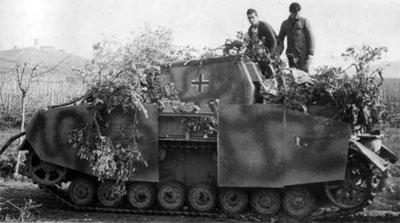 |
| The meant the vehicle was very overloaded and put great burdens on the driver’s skill. Nonetheless after the first successful combat reports started to return, Hitler decided to resume production at 10 units per month starting in December 1943.9 |
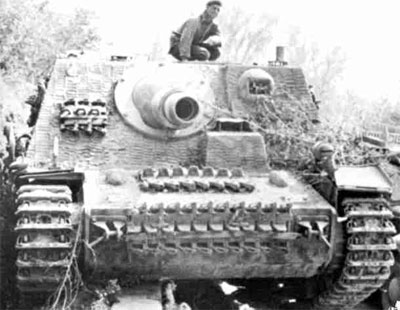 |
First Production Series
Since the turret and superstructure of the original Panzer IV’s was to be removed, Alkett designed a six-sided casemate with the following specifications.
| Location |
Armour Thickness / Angle
|
Front
|
100 mm / 40°
|
Side
|
50 mm / 18°
|
Side Front
|
50 mm / 25°
|
Chassis Bow
|
50 + 50 mm / 15° (Upper Part)
|
| |
30 + 30 mm / 59° (Lower Part)
|
| Roof |
20mm / 84°
|
Back
|
30 mm / 26° (only upper third part, otherwise straight10
|
|
As mentioned previosuly, the original 60 production models were built upon Panzer IV E and G modals. The original PIV/E chassis wasn’t changed, that means their partial armour at the chassis sides were unchanged and the longer exhaust pipes remained as they were. The upper construction was removed, but the engine covering didn’t receive any modification. The driver was located in a slightly protruding structure and a drivers visor type 80, similar to that fitted to the Tiger, was added. Some vehicles also received additional further armour plating that was fixed to the lower slide.
This armour plate was intended to hinder shots from penetrating that weak part of the vehicle after they were deflected by the angled bow plate. The 15cm howitzer was off set to the right of the 100mm thick superstructure front plate.
|
A 100mm thick ball mounting protected the barrel cradle and other parts of the internally located gun parts. Each side of the upper structure featured a closable sub-machine gun/pistol port for close defence.
The back of the upper structure also sported two escape/entry hatches and two open top boxes were added, which housed the fighting compartments ventilators. On the back of these were located the two antenna sockets.
|
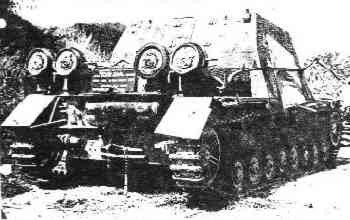 |
Located on the superstructure roof are two two-part hatches, a round one for the commander and a square one for the gunners. A further two-part hatch was positioned at the rear of the superstructure. The front hatch of the sighting/aiming gunner featured an opening for a Sfl.Zf 1a aiming sight (self-propelled aiming sight 1a). It was possible to use a MG 34 via the loaders hatch, similar to the StuG III. Also, large accessory and tool boxes were fixed on the vehicle's right side. Furthermore, on the back of the engine compartment holdings for extra road wheels were added.
Most of them received fittings for the famous Schuzen.11
|
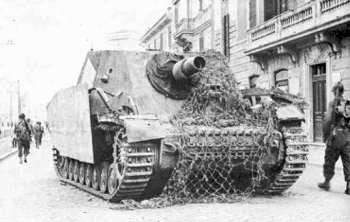 |
Middle Production Series
After production was resumed, the unmodified PIV/H chassis was used as the basis for new vehicles.
The upper construction remained largely unchanged, but the driver’s structure was changed. The drivers visor was exchanged for an angled mirror system, similar to the late Panzer V production. Some of them received rain protection plates fixed above the mirror. Also the armouring of the gun mantlet was increased.
|
Additionally a ventilator in front of the loaders hatch was added, but the two ventilators at the back were deleted. Also, just one antenna socket instead of two was installed.
Furthermore the loader's hatch was deleted and the tool boxes moved to the right side. Apart from some other minor changes, the vehicle remained the same.12
|
Late Production Series
The late production vehicle, starting in June 1944, was based upon the PIV/J chassis. The previous hexagonal-shaped upper structure was changed to a more conventional square shape.
Furthermore, the whole roofing configuration was changed. There were two ventilators, one at the upper front right and one above the new ball mounted MG-34, located towardsthet left side above the driver. Also two small hatches were added on the rear roof.
|
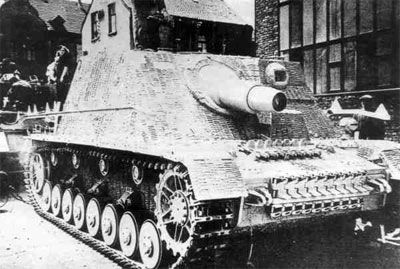 |
The commander received a new sighting cupola, similar to that installed in the StuG III. It was possible, but never done, to fix a MG to this turret for anti-air defensive purposes. The back was also redesigned, with a small structure with two entry/escape hatches.
The biggest change was the implementation of the new all steel road wheels. The number on individual vehicles varied from the front pair to all eight wheels per side. Some vehicles of that series featured a new exhaust system with two pipes protruding.
Vehicles from all three production series received the anti-magnetic Zimmerit coating.13
|
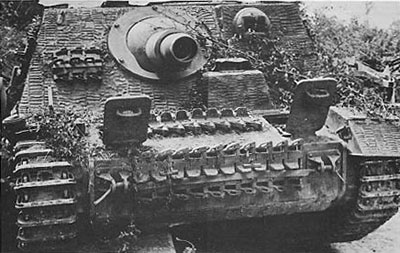 |
After the first series, the superstructures were produced by the Bismarckhütte company. All in all 368 vehicles were manufactured by the Deutschen Eisenwerke and Nibelungenwerke. The chassis numbers were 80801 – 84400, 86601 – 87100 and 89101. Production ceased in March 1945, with 306 new and 62 reconstructed vehicles in total.14
The following list, compiled by Richard Hadrick, states the complete production/distribution numbers for the StuPz IV.
Production/Issued list PDF...
|
Ammunition
The “Brummbär” was able to fire two different rounds, either the 15 cm lgr 38 FES, a 38 kg weighting, 660mm long high-explosive, travelling 240 m/second or the 15 cm lgr 39 Hl/A, a 25 kg weighting 572 mm long hollow charge anti-tank, travelling 275 m/second.15
The development of a “mine grenade” was under way, but not completed.16
|
References
1 Letter No. 548/41 gKdos dating that day, in Spielberger, p. 101
2 Spileberger p. 101, other sources state October 6th
3 Spielberger p. 101, Engelmann p. 29
4 Jaugitz p. 6 and 7
5 Jaugitz p. 6
6 Spielberger p. 102
7 Engelmann p. 30
8 Spielberger p. 102
9 Spielberger p. 103
10 Jaugitz p. 8
11 Jaugitz p. 8 & 9
12 Jaugitz p. 12
13 Jaugitz p. 14
|
Last Updated On Wednesday, January 23, 2013 by Blake at Battlefront
|
|
|